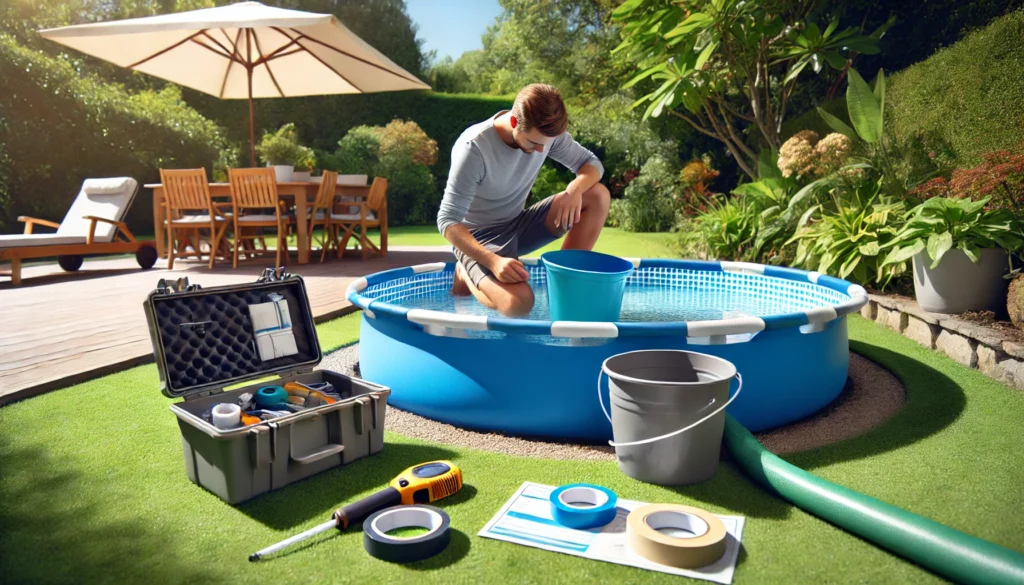Explore how to find a leak in an above ground pool creates significant summer enjoyment, yet leaking problems rapidly convert the experience into frustrating situations. Detect and repair pool leaks without delay when water loss surpasses standard evaporation rates because such situations will become more problematic. Frequently locating water leaks helps both protect your swimming pool structure against repair expenses and increase its operational life. The guideline below demonstrates proper methods to identify leaks while outlining solutions for their resolution.
Common Signs of a Leak in an Above-Ground Pool
Discovery of how to find a leak in an above-ground pool at its initial stage helps prevent monetary expenses and missed enjoyment. Little leaks will escalate into serious problems that cause pool water depletion, damage to structural elements, and elevated maintenance expenses. Detecting these warning signals enables you to prevent substantial problems from occurring.
Unexplained Water Loss: A leak exists when your pool loses more than half an inch to one inch of water daily.
Damp or Soggy Ground Around the Pool: Leaky water can appear as wet spots that form near the pool lining.
Decreased Water Pressure in the Pump System: If your filter system seems to be working harder with reduced efficiency, a leak might be the culprit.
Visible Tears or Holes in the Liner: The vinyl liner loses water whenever there is any size opening in its material.
Air Bubbles in the Return Line: Too much bubbling from return jets indicates airflow that plumbing leaks could cause.
Difficulty Maintaining Proper Water Chemistry: If chemical levels fluctuate abnormally, water loss due to a leak might dilute the balance.
Warped or Shifting Pool Structure: A weakening pool frame or shifting walls may indicate water escaping underneath.
Preparing to Detect the Leak In An Above Ground Pool
Before diving into detection methods, take the time to examine how to find a leak in an above-ground pool. To test underwater successfully, you need to disable all pool pumping and filtration equipment that keeps the water stagnant. Floating objects must be removed from the water surface to prevent disturbance of the test. Obtain necessary equipment, including food coloring, together with a bucket, repair kit, and waterproof tape for the examination. Understanding where to look first will streamline the process and make locating the leak easier.
Step-by-Step Methods to Find the Leak
Identifying leaks within above-ground pools proves difficult initially, but appropriate examination methods allow you to detect faults rapidly. Smooth tests combined with detailed pool observation will reveal even minor leaks to prevent significant harm. Adopting an orderly approach enables you to minimize water loss and to avoid pool harm while ensuring no substantial repair expenses arise.
Inspecting the Pool Liner for Visible Damage
Begin by visually inspecting how to find a leak in an above-ground pool. Check for noticeable rips, tears, or weak seams. The perimeter of the pool ladder, along with the skimmer and filter junctions, yields the most failures. To check for potential problems in your pool with a vinyl liner, you should lightly press your fingers on the bottom to find light and curved areas.
The Bucket Test for Water Loss Confirmation
To determine if water loss is due to evaporation or an actual leak, perform a bucket test. Fill a bucket with pool water and place it on the pool step or a stable floating surface. Mark the water levels inside the bucket and on the pool wall. After 24 hours, compare the levels. A leak is present if the pool water level has dropped more significantly than the bucket’s.
Using Food Coloring to Spot Small Leaks
For pinpointing tiny leaks, use food coloring. While standing still in the pool, release a few drops of food coloring near suspected leak areas, such as around seams, skimmer connections, or drain fittings. Watch how the dye moves. If it gets sucked into a particular spot, that’s where your leak is.
Examining the Pool Equipment & Fittings
Leaks are not always in the liner—they can originate from pool equipment. Inspect the pump, filter, hoses, and connections for drips or water accumulation signs. If air bubbles appear in the return line, a plumbing leak could allow air into the system. Tighten fittings and replace worn-out gaskets or O-rings if needed. Stay with us to learn how to find a leak in an above-ground pool!
Checking the Ground for Wet Spots or Soft Areas
If you notice consistently damp areas near the pool base, dig slightly into the soil to check for excessive moisture. The soft or eroded ground around the pool wall suggests water escaping below the structure. This method helps detect underground leaks that might not be immediately visible.

How to Fix Common Above-Ground Pool Leaks
Addressing above-ground pool leaks does not lead to stressful circumstances. Essential solutions can be found to fix all types of pool damage, such as sheet tears, pipe leaks, and punctures. Using proper tools alongside appropriate techniques will allow you to rapidly fix leaks, thus maintaining an optimal condition for your pool throughout the season.
You Might Also Like: How To Delete Walmart Account
Patching Small Tears in the Liner
If it is in the liner, you can understand how to find a leak in an above-ground pool using a vinyl repair kit. Most kits come with waterproof adhesive and patches that work even underwater. Clean the affected area thoroughly before applying the patch. Press it firmly to ensure a secure seal, and let it cure for the recommended time before refilling the pool.
Repairing Leaks Around Pool Fittings and Seams
Leaks around skimmers, return jets, and seams require specialized fixes. Apply waterproof silicone sealant to reinforce weak seams. For leaking skimmers or return fittings, tighten screws or replace rubber gaskets to create a watertight seal.
Fixing Leaks in the Pump, Filter, and Hoses
If the leak stems from the pump or filter system, check for cracked housings, loose clamps, or damaged hoses. Replace worn-out parts immediately. Wrap leaking hose connections with waterproof tape as a temporary fix until a permanent replacement is installed.
Preventing Future Leaks
How to find a leak in an above-ground pool, freedom depends heavily on the practice of preventative maintenance. Regular visual checks of the liner should detect wear before it develops into significant problems. Separate the pool area from all objects potentially harming the liner structure. The water chemistry balance must be controlled to protect the liner from damage. The proper winter storage for your pool protects from cold temperature damage and prevents the formation of pool-related cracks.
Frequently Asked Questions
How do I know if my pool is leaking?
Perform the bucket test—you leak if the pool water drops more than the bucket.
Where do most above-ground pool leaks occur?
Common leak points are liner tears, seams, skimmer, return fittings, pump, filter, and hoses.
Can I fix a liner leak without draining the pool?
Yes, use a vinyl patch kit designed for underwater repairs.
Conclusion
Detecting and learning how to find a leak in an above-ground pool ensures a stress-free and enjoyable swimming experience. Identifying leaks early and using simple repair methods can prevent costly damage and maintain your pool’s longevity. Regular inspections and preventative care will keep your pool in top condition, allowing you to enjoy endless summer fun without disruptions. Stay proactive, and your pool will stay leak-free for seasons to come!




[…] You Might Also Like: How To Find A Leak In An Above Ground Pool […]